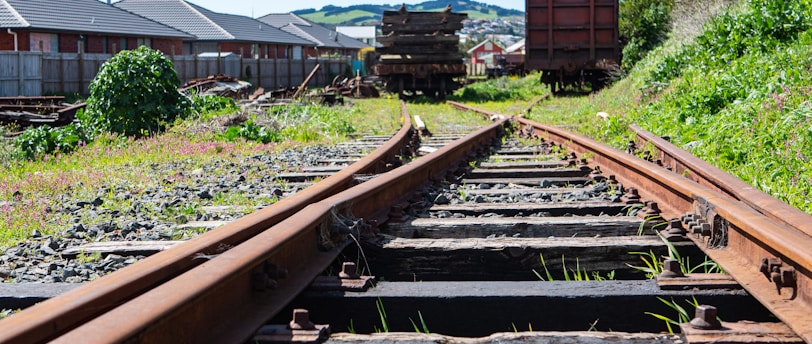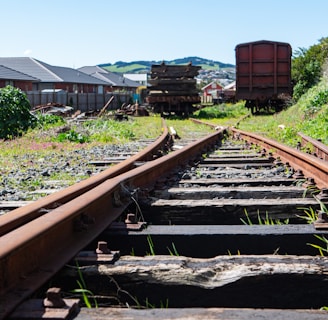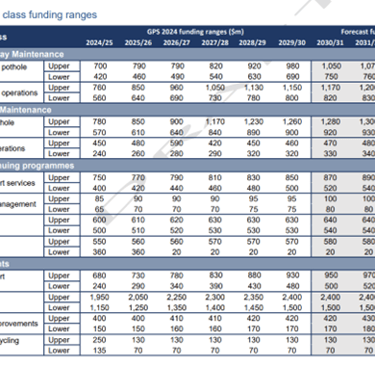What Government Plans Mean for Rail
Government plans released over the past few months signal rocky times ahead for our rail network. Let's unpack why.
RESILIENCEPLANNINGINFRASTRUCTURECONNECTIONINVESTMENT
3/17/202410 min read


The Coalition government has given a clear indication as to where it sees rail going in the future and it’s not good news for transport choice, resilience or the environment in New Zealand. The good news is that there’s still time to change direction.
As with most policy documents, the devil is in the detail. This article scans the key policy announcements to highlight areas that have the most impact on our rail network and services.
Government Policy Statement (GPS) on Land Transport
We’ll summarise some of the key statements and what they could mean for our national rail network. Consultation on the GPS remains open until 2 April 2024. It is important that the government receives feedback from a wide range of groups and individuals. Find out more about having your say here.
Rail reduced to bare basics.
Rail has largely been written out of the GPS, but a statement on p.15 gives an indication as to where the Coalition's national rail network priorities are:
“This Government’s focus will be to invest in maintaining the network between the busiest and most productive parts of the existing rail network – between Auckland, Hamilton, and Tauranga.”
The above statement, when read alongside the removal of funding streams for rail and the termination of the iReX Cook Strait ferry project, sends a strong signal that the Coalition is looking to reduce its involvement with rail. At best, the rail network risks being reduced to an Auckland-Tauranga freight line (and associated direct feeder lines within the Golden Triangle / BoP area), alongside existing commuter rail networks in Auckland and Wellington, this would include the Lower North Island Rail Integrated Mobility (LNIRM) new inter-regional rolling stock and upgrades for lines to Palmerston North and Masterton from Wellington which is in the current Coalition Government agreement.
It’s worth pointing out that Golden Triangle freight doesn't exist in isolation from other regions. Rail works best for moving freight long distances. A proportion of freight going to and from the Port of Tauranga will be bound for other parts of the country. Focusing on the Golden Triangle at the expense of the rest of NZ is like taking the engines off a plane to reduce its weight expecting the plane to still be able to fly and carry its passengers.
Removal of rail funding.
The draft GPS removes the ability for the rail network to access the National Land Transport Fund (NLTF). Rail is clearly land-based transport. The NLTF comes from a range of funding sources, despite the Government’s assertion that it’s solely from road use charges. This reduces the rail network funding from Track User Charges (TUC), ie. direct users only. The GPS suggests these may be as low as $20 million from 2026. This is between 5% and 10% of the funding needed to fund the national rail network infrastructure. KiwiRail CEO, Peter Reidy, has said it would not be possible to run the rail network with that level of funding. Further by expecting rail users to directly fully fund the rail network they use through TUC’s it is highly likely that most users - including many that use the Golden Triangle might be priced off rail altogether placing even the Golden Triangle sub network at risk.
Equally concerning is the recommendation that decisions on rail funding be moved outside of accepted land transport policy and planning mechanisms. This change places rail as discretionary spending dependent on the Minister of the day, as opposed to part of our land transport strategy and makes future planning difficult.
But wait, it gets even worse. The following statement in the GPS about the rail network funding class should send shivers up the spines of anyone who cares about sustainable transport, social cohesion, road safety, and economic growth. The addition of the words “if any” suggests that no additional fund for rail could be on the table. $20 million isn’t enough to run a national connected railway, so it possibly indicates the mothballing, sale or lease of most if not all of the rail network could be on the cards.
“NLTF Funding for this activity class will be capped at the level of revenue from Track User Charges (TUCs) and specific Crown funding for rail investments (if any). The Government expects that activities funded through this activity class will be targeted to parts of the rail network where the most significant economic benefits and opportunities for boosting the productivity of freight movement exist, i.e., Auckland, Hamilton, and Tauranga.” p.28.
If you are finding some hope in the publication of upper ends of funding bands for activity classes, then we are sorry to dash that too, because according to the draft GPS “the expenditure targets do not envisage funding being allocated at the top end of every activity class range” p.28.


So, what might it directly mean for the rail network?
Some parts of the national rail network could survive retrenchment, including:
The Golden Triangle: Auckland to Hamilton to Tauranga, with associated feeder lines.
Lower North Island: Wellington to Masterton / Palmerston North, for passengers and freight.
Some short lines connecting industry to ports.
However, without funding, other parts of the rail network could be threatened unless a group of customers were willing to fully underwrite them. These could include:
North of Auckland (unless Northport growth plans go ahead)
Marton to New Plymouth
Palmerston North to Napier and Wairoa
Wairarapa from Masterton to Woodville
Main North Line from Christchurch to Picton
Main South Line from Timaru to Dunedin
Perhaps, most culturally impactful, the iconic North Island Main Trunk line south of Otorohanga to Palmerston North could also be threatened if South Island bound Inter-island rail tonnage ends and feeder lines from New Plymouth and Napier are terminated.
Obviously, this could also spell the end of the iconic Northern Explorer train between Wellington and Auckland.
None of this is predetermined, but it’s useful to consider a possible future for rail in NZ if it isn’t supported by the government.
Well, that sounds dire…how about passenger rail?
When it comes to passenger rail, the GPS is a fish-flavoured cupcake with a cherry on top.
“It is expected that funding in this activity class [public transport infrastructure] will be used to invest in projects that reflect the priorities of this GPS, including a rapid transit network in Auckland and upgrades to rail in the lower North Island” p.26.
Let’s talk about the cherry first. The GPS does provide funding to complete the Auckland City Rail Link and associated infrastructure rebuild, as well funding for new trains and some rail infrastructure for Wellington and the Lower North Island.
But here’s the part that will leave a fishy taste in your mouth. The GPS requires greater farebox recovery by local government. This means higher fares for passengers.
“Increased public transport fare-box recovery and third-party revenue will be expected from local government” p.14.
Some fares are already high. The standard adult fare on the Capital Connection between Wellington and Palmerston North is $35. An increase in fares, without a corresponding increase in quality and frequency could negatively affect patronage. Te Huia between Hamilton and Auckland could also face issues unless additional funding was found.
Finally, not to state the obvious, but trains need tracks. So, things don’t look great when the passenger rail is considered alongside potential cuts to the national rail network. The potential for new services would be severely diminished.
Regional Councils have particular right to be concerned. If freight traffic significantly diminishes, or is absent, from sections of lines (such as the track between Wellington and Palmerston North) then the potential burden of track maintenance costs could fall on them. This would place a significantly higher burden on their ratepayers in order to keep fares at a sustainable level that passengers would tolerate. This represents a potentially significant fiscal hole for regional councils.
Refocusing Waka Kotahi NZTA on roads, and away from rail.
Waka Kotahi, the New Zealand Transport Agency (NZTA), has a broad remit on transport delivery. The GPS refocuses that remit squarely on roads, at the expense of rail, public transport, and cycling and walking. The Statement of Ministerial Expectation states “while NZTA supports other agencies to deliver other parts of the transport network, it should ensure that its focus is on building and maintaining our state highway roading” (p.33). The adjoining paragraph adds: “Work on programs which are not aligned with NZTA’s core purposes or with the GPS should be discontinued.” These are clear statements that transport planners are being asked to drop tools on rail and public transport and start chipping away at mega roading projects.
If Waka Kotahi NZTA are forced to primarily focus on roads this means that any hope of national integrated transport policy and delivery are all but lost. If anything, the Waka Kotahi NZTA should have public transport and rail division leadership at the top table. This draft policy, as it currently exists, seeks to dilute even further what is already a very weak position that public transport and rail have in the organisational structure.
Where is the South Island?
Well, we know where it is, but after reading the GPS, you’d be forgiven for thinking that it’s disappeared. There is no reference to the potential for passenger rail services in our second largest city. Even the list of the Coalition’s rail projects neglects the South Island, (except for a small freight hub in Ashburton). This reflects the Government’s prioritisation of Auckland-Tauranga freight and Auckland and Wellington commuter trains.
When you read the GPS alongside the decision to scrap the iReX rail ferries, a clear picture starts to emerge. Cutting inter island rail freight possibly makes most, if not all, rail in the South Island unviable. This could lead to the progressive mothballing of the South Island rail network and the end of our national rail system.
Is the Government planning to sell rail corridors and land?
The following short, innocuous statement sneaks its way onto page 9 of the GPS under the heading of System Reform:
“Making it easier to sell land that is no longer required for transport purposes.” p.9.
Disassembling rail infrastructure and building on railway land reduces options to restore rail services and build new public transport infrastructure in the future. It locks us into car dependency and reduces transport choice. Rail land is a state asset and people should have a say on if it’s sold, or how it’s used. Yet, the implementation of fast tracking of consents for major infrastructure projects by Ministers could give them unbridled power to sell or build on transport land.
A transport plan full of ‘own goals.’
The Government lists four key strategic priorities on p.4 of the GPS:
Economic Growth and Productivity
Increased Maintenance and Resilience
Safety
Value for Money.
According to the Coalition Government, roads are the answer to meeting all these priorities. There’s no doubt that roads help connect people and lubricate the economy, but relying on just roads to achieve priority outcomes is myopic and ideological. Take for example, the focus on increased maintenance and resilience. Clearly having more heavy trucks pounding and smashing roads will increase maintenance costs and reduce safety for motorists compared to putting more freight on trains. Likewise, relying on only one mode of transportation will reduce resilience of the network. We also know that a third of the adult population does not hold a driver's licence and with an ageing population the numbers who cannot, or should not drive, will increase. A safe, resilient, and quality transport system is a diverse transport system.
The same can be said for economic growth. We know that building more roads means more traffic. There are decades of data to prove that (or you just inherently know that as you sit in a traffic jam). Unlocking access to greenfield land and building satellite towns and roads, creates more congestion, whereas investing in public transport creates more choice. A driver stuck in traffic is not productive. Their contribution to economic growth is minimal when compared to someone working on a train, or someone who made it to work on time.
“New Roads of National Significance and major public transport projects will unlock access to greenfield land for housing development and support greater intensification to ultimately improve housing supply, choice and affordability” p.10.
The Government’s transport plan will create more congestion, increase maintenance costs, reduce safety, and cost people more.
We haven’t mentioned carbon emissions because they’ve removed that as a priority from their transport plan. They shouldn’t have. Transport is our second largest and fastest growing source of carbon emissions. Not addressing transport emissions will have environmental, economic, and health impacts of a magnitude that’s hard to quantify.
Cook Strait ferries. The thread that shouldn’t be pulled.
Without rail ferries, there is no national rail network. The Government cancelled the iReX ferries but has yet to announce a replacement. Nicola Willis famously said we need to find a Corolla when she cancelled the Cook Strait ferries. We need to aim higher than that. We need ferries that can carry trains. The cancellation of the Cook Strait rail ferries is the thread we shouldn’t pull. Doing so could unravel our entire rail network with devastating consequences for our society and economy. It’s hard to think of infrastructure more important than uniting the two halves of our country. That said, if you were a government with a sinister plan to do away with rail, cancelling rail ferries would be a logical place to start, but surely our government is better than that.
Further, keeping a rail enabled connection between the islands, concurrently with the national rail network, should be considered critical in the increasingly unstable geopolitical climate. This is especially good insurance in the event of global supply chain disruption where New Zealand could find itself somewhat isolated. Indeed, this is precisely why many countries are strengthening and building new rail connections across the world rather than weakening them. History has proven the worth of rail time and time again.
In a time of an increasingly uncertain world, it is most certainly in the national interest for the Government to preserve and improve the rail connection between the North and South Island. This means the terminals in both Picton and Wellington should be resilient and built to the best standards within a fiscally responsible envelope.
Government’s exist to protect the national strategic interest and a resilient national rail network is absolutely in the national interest. Indeed, rail should be considered among the most important ‘roads of national significance’ (RONS) of them all.
You have until 2 April to comment on the GPS. Find out how at www.transport4all.org.nz
